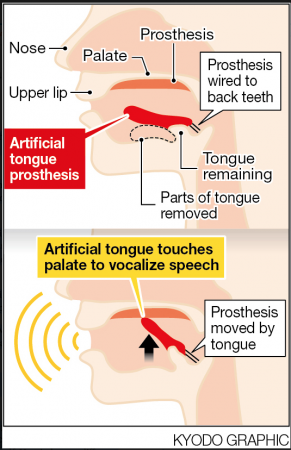Source: www.japantimes.co.jp
Author: Tomoko Otake
Dentistry researchers at Okayama University have come up with what could be the world’s first movable tongue prosthesis to help oral cancer patients who have partially lost the ability to speak.
The invention, the product of a team led by Shogo Minagi, a professor of dentistry at the university, is good news for scores of oral cancer victims in Japan with speech problems.
The number of oral cancer patients in the nation has surged to 7,800 in 2015, up from around 2,100 in 1975, according to estimates by the Japan Society of Oral Oncology. The figure does not include those with damaged tongues from traffic accidents and other physical injuries.
Minagi’s work was inspired by Kenichi Kozaki, also a dentistry professor at Okayama University and an expert on dental pharmacology. Kozaki was diagnosed with tongue cancer in May 2014 and has had most of his tongue surgically removed. Kozaki asked Minagi to create a tongue prosthesis that he could use to speak. Minagi said he looked into tongue prostheses developed in the past but found just one paper in Japan, in which the artificial tongue was part of a denture and could not be moved.
“Developing an oral prosthesis is a painstaking process for patients,” Minagi said by phone Monday. “This time, we could create a really good prosthesis quickly thanks to Kozaki, who is a dentist himself. He tried many different versions of the prosthesis and offered us detailed feedback.”
When a person speaks, the tongue needs to touch the palate, but people whose tongues have been removed are unable to do this and thus have difficulty speaking.
The tongue prosthesis developed by Minagi’s team and made from resin can move up and down in the mouth as it is connected to the back teeth by a wire. Users can control the device by pushing it with the remaining base of their tongue, Minagi said, noting that many users also wear a resin filling over their palate to make it easier for the device to make contact.
He said he hopes the device will become widely available.
“We have used materials that are already widely used, so any dental technician can make this type of prosthesis,” Minagi said. “We would like to share our know-how widely with clinics nationwide, to help as many people as possible.”
According to Minagi, Kozaki, who is still battling cancer after having most of his tongue, jaw bones and pharynx removed, has also expressed hope that more people will learn about the device and find their voice again.
In September, Okayama University opened an outpatient clinic called Yume no Kaiwa Purojekuto Gairai (Outpatient Clinic to Achieve the Dream of Speaking Project).
At least four people are currently having artificial tongues made through the clinic, Minagi said, adding that it takes several months for technicians to adjust the prosthesis to fit users, and for the users to train their muscles to speak through the device.


Leave A Comment
You must be logged in to post a comment.